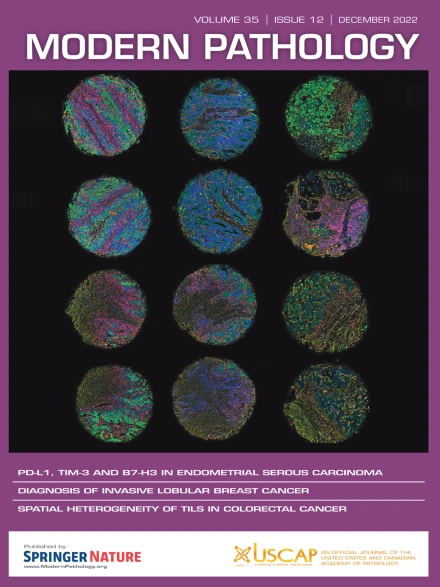International Feasibility of Applying Diagnostic Essential Criteria of the Fifth Edition World Health Organization Classification of Female Genital Tumors: Evidence for a Global Gap in Health Care Equity
IF 5.5
1区 医学
Q1 PATHOLOGY
引用次数: 0
Abstract
The new categories of diagnostic essential criteria and desirable criteria in the fifth edition World Health Organization Classification of Female Genital Tumors (fifth WHO FGT) aim to standardize the classification of gynecologic tumors worldwide. As some essential criteria require biomarkers (immunohistochemistry [IHC] or molecular tests), we hypothesized that the applicability of the fifth WHO FGT criteria may be limited by access to these tests due to local resource constraints. After defining the essential biomarkers in the fifth WHO FGT, we conducted an international survey of pathologists to determine accessibility to essential biomarkers and then evaluated access as a function of the pathologist’s country income category. A total of 37 IHC and 6 molecular tests are considered essential for diagnosing a spectrum of common and less common tumors. Among 480 respondents from 76 countries, access to the printed or online version of the fifth WHO FGT was associated with country income (P < .0001); 62.5% of low-income country respondents reported no access to either version. Routine access to IHC in general and routine access to each of the essential IHC were significantly associated with the country income category (P < .0001). Only 12.5% of low-income country respondents reported routine access to IHC in general, and none reported routine access to any essential molecular tests. Short tandem repeat genotype testing for molar pregnancy diagnosis was the least accessible essential molecular test worldwide, available to only 26.6% of the respondents, most of whom were in high-income countries. Additional essential criteria for some tumors consisted of one of 18 different specific types of tumor differentiation for which no morphologic definition was provided; high-income country respondents were more likely to routinely use IHC in these settings than lower-income country respondents (P < .0001). Conversely, the patient bore the direct responsibility for paying for IHC when used in lower-income countries compared with high-income countries (P < .0001). This survey demonstrates a global gap in health care equity due, in part, to limited access to biomarkers deemed as essential for diagnosis by the fifth WHO FGT and to the lack of diagnostic criteria adaptable to resource-limited environments. Based on the survey results, we offer several practical strategies for narrowing this gap in future editions of the WHO FGT, chief among them being a move toward resource-stratified diagnostic criteria.
应用第五版世界卫生组织女性生殖器肿瘤分类诊断基本标准的国际可行性:卫生保健公平全球差距的证据。
第五版《世界卫生组织女性生殖器官肿瘤分类》(5th WHO FGT)新增了诊断基本标准和期望标准两大类,旨在规范世界范围内妇科肿瘤的分类。由于一些基本标准需要生物标志物(免疫组织化学(IHC)或分子检测),我们假设由于当地资源限制,第5世卫组织FGT标准的适用性可能受到限制。在第5次WHO FGT中定义了基本生物标志物后,我们对病理学家进行了一项国际调查,以确定基本生物标志物的可及性,然后评估病理学家国家收入类别的函数可及性。共有37项免疫组化检测和6项分子检测被认为是诊断一系列常见和不常见肿瘤的必要手段。在来自76个国家的480名答复者中,获得世卫组织第5次财务指标的印刷版或在线版与国家收入有关(第7页)
本文章由计算机程序翻译,如有差异,请以英文原文为准。
求助全文
约1分钟内获得全文
求助全文
来源期刊

Modern Pathology
医学-病理学
CiteScore
14.30
自引率
2.70%
发文量
174
审稿时长
18 days
期刊介绍:
Modern Pathology, an international journal under the ownership of The United States & Canadian Academy of Pathology (USCAP), serves as an authoritative platform for publishing top-tier clinical and translational research studies in pathology.
Original manuscripts are the primary focus of Modern Pathology, complemented by impactful editorials, reviews, and practice guidelines covering all facets of precision diagnostics in human pathology. The journal's scope includes advancements in molecular diagnostics and genomic classifications of diseases, breakthroughs in immune-oncology, computational science, applied bioinformatics, and digital pathology.
 求助内容:
求助内容: 应助结果提醒方式:
应助结果提醒方式:


